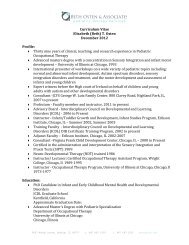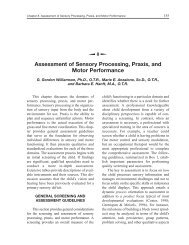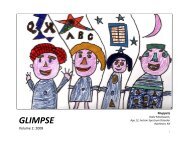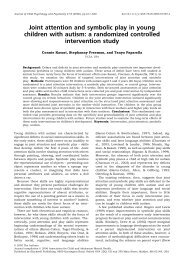FLOORTIME: WHAT IT REALLY IS, AND WHAT IT ISN'T By Stanley I ...
FLOORTIME: WHAT IT REALLY IS, AND WHAT IT ISN'T By Stanley I ...
FLOORTIME: WHAT IT REALLY IS, AND WHAT IT ISN'T By Stanley I ...
You also want an ePaper? Increase the reach of your titles
YUMPU automatically turns print PDFs into web optimized ePapers that Google loves.
<strong>FLOORTIME</strong>: <strong>WHAT</strong> <strong>IT</strong> <strong>REALLY</strong> <strong>IS</strong>, <strong>AND</strong> <strong>WHAT</strong> <strong>IT</strong> <strong>IS</strong>N’T<br />
<strong>By</strong> <strong>Stanley</strong> I. Greenspan, M.D.<br />
Floortime, as you know, is at the heart of our DIR/Floortime Model, and it’s at the heart<br />
of a comprehensive program for infants, young children, and families with a variety of<br />
developmental challenges including autistic spectrum disorders. This comprehensive<br />
program includes working on all the elements of the DIR/Floortime Model – the<br />
functional emotional developmental levels, the individual processing differences and<br />
creating those learning relationships that will help the child move ahead in their<br />
development – relationships that are tailored to their individual differences that move<br />
them up the developmental ladder, mastering each and every functional emotional<br />
developmental capacity that they are capable of. The DIR/Floortime Model involves<br />
often not just Floortime, but different therapies like speech therapy, occupational therapy,<br />
physical therapy, education programs, counseling support for parents, and intensive home<br />
programs as well as school programs.<br />
Today we really want to focus on the Floortime component, which is at the heart of the<br />
home component and also at the heart of the other components that must be carried out at<br />
school. In other words, Floortime is a particular technique where we get down on the<br />
floor and we work with the child to master each of their developmental capacities. But it<br />
is also a philosophy that guides the way occupational therapists work and speech<br />
pathologists work and educators work with the children. So you need to think about<br />
Floortime in two ways:<br />
1. A specific technique where for 20 or more minutes mommy or daddy gets down<br />
on the floor with little Johnny or Susie.<br />
2. A general philosophy that characterizes all the interactions with the child, because<br />
all interactions have to incorporate the features of Floortime as well as the<br />
particular goals of that interaction, be it speech therapy or occupational therapy or<br />
special set of educational goals.<br />
In thinking what Floortime is and what Floortime isn’t, we will define it in a way that<br />
will hopefully help both professionals and parents understand why Floortime is the<br />
cornerstone, the engine that drives the DIR/Floortime Model and drives the<br />
developmental process. At the heart of our definition of Floortime are two of what could<br />
be called emphases that sometimes work together very easily and other times may appear<br />
to be opposite ends of the continuum:<br />
1. Following the child's lead<br />
2. Joining the child's world and pull them into a shared world in order to help<br />
them master each of their Functional Emotional Developmental Capacities.<br />
We have to always have to be aware of both of these polarities, tendencies or dimensions<br />
of Floortime. Read more<br />
1
1. Following the Child's lead<br />
The most widely known dimension of Floortime is following the child’s lead,<br />
harnessing the child’s natural interests. Why do we follow the child’s lead? After all,<br />
we are trying to teach the child, and in the history of education, we have often felt that<br />
children have to be taught things they don’t want to learn, that we can’t just do what a<br />
child wants to do because children are historically viewed as creatures of their instincts;<br />
creatures of their “primitive pleasures” and they would never get socialized if we just did<br />
what they wanted to do and followed their lead. So why do we follow the child’s lead?<br />
Why do we take our clue and our cue from the child? Well a child’s interests or the<br />
child’s lead is the window to their emotional life. Through the child’s interests;<br />
through the child’s natural desires, we get a picture of what is enjoyable; what is joyful;<br />
what is pleasurable for that child. For example, a child is staring off at a fan. That<br />
seems like something inappropriate and something we want to discourage. But yet<br />
something about that is meaningful or pleasurable to the child. The child is rubbing a<br />
spot on the floor over and over again. Something that is meaningful or pleasurable about<br />
that to the child. The child is opening and closing his door repetitively or aimlessly<br />
wandering around the room. So we always start off with asking the question which must<br />
be asked: Why is little Johnny or Susie doing that? And to simply say it’s because he or<br />
she has this or that disorder; that it’s due to their autism or due to their Down’s<br />
Syndrome or due to their “this or that” doesn’t answer the question. Little Johnnie or<br />
Susie are human beings. They may have a disorder or a set of problems, but they are not<br />
the disorder or set of problems. They are human beings with real feelings and real<br />
desires and real wishes. Sometimes maybe they can’t express or tell us about it, so we<br />
have to say from what they are doing if they can’t tell us about it, what does this tell us<br />
about what they enjoy in life? What is giving them pleasure? Why does it have meaning<br />
for them? So we follow their lead at the entry point because the first goal is to join them<br />
in their world, but not stay in their world with them, but to pull them into a shared world<br />
where they are a part of a world with us. In all human development, it begins with that<br />
relationship between the caregiver and the child joining into a shared world. It doesn’t<br />
happen just in human beings. It happens in our non-human primate cousins like<br />
chimpanzees. It happens even in other mammals where we will see a puppy dog and the<br />
mommy dog playfully interacting together. So in many forms of life, development<br />
begins with a shared world between the caregiver and nurturer and the helpless infant.<br />
So the goal is to pull the child into a shared world from their world, but we don’t want to<br />
pull them in screaming and yelling and yipping. We want to pull them in with real<br />
warmth and pleasure. We want the child to want to be in the shared world and that’s the<br />
key. How do we help the child want to be in a shared world with us? For a variety of<br />
reasons, a child may have elected to be more self-absorbed or more aimless and<br />
seemingly in his or her own world. What will motivate them to be a part of a shared<br />
world? Well, the first motivation is to join them in their world and show them that you<br />
can respect what they are interested in. So if the child is aimlessly wandering around the<br />
room and jumping, we wander and jump with the child. The child then experiences a<br />
partnership in aimless wandering and jumping. Or we might rub a spot on the floor with<br />
them. But, that’s one part of the equation – following their lead. If a child is moving a<br />
2
truck, we may move a truck with them. We can put our hand so they can move the truck<br />
towards our hand, pretending our hand is a tunnel. But these are all ways of following a<br />
child’s lead, entering their world to pull them into a shared world. We will see that as a<br />
child, instead of looking annoyed or looking irritated or running away from us,<br />
starts giving us some friendly looks and some warm smiles and some friendly<br />
glances. That’s the beginning of that shared world.<br />
2. Joining the child's world and pull them into a shared world in order to help<br />
them master each of their Functional Emotional Developmental Capacities.<br />
Following the child's lead is only one half of the equation; one half of this dynamic that<br />
we call Floortime. There is another half. The other half; the second part of it is we join<br />
them in their world and pull them into a shared world in order to help them master each<br />
of their Functional Emotional Developmental Capacities. These are the fundamentals of<br />
emotional, social, language, and intellectual development. When we talk about<br />
Functional Emotional Capacities, we’re talking about the fundamentals of relating,<br />
communicating, and thinking.<br />
So we have a bigger goal in joining them in their world. We want to pull them into our<br />
shared world to teach them and help them learn how to focus and attend, how to relate<br />
with real warmth, how to be purposeful and take initiative, and have a back-and-forth set<br />
of communications with us through gestures, and eventually through words. We want to<br />
teach them how to problem solve and sequence and get them involved in a continuing<br />
interaction with their environments and the people in their environments. We want to<br />
teach them to use ideas creatively and then we want to teach them to use ideas logically<br />
and then progress up the developmental ladder until they are not only using ideas<br />
logically but actually showing high degrees of reflective thinking and high degrees of<br />
empathy and high degrees of understanding the world so that they can evaluate their own<br />
thoughts and feelings and say things like, “Gee, I’m angrier than I should be today” or “I<br />
agree with Mark Twain, but I disagree with Tolstoy because Twain had a similar<br />
upbringing to my upbringing.” That’s our ultimate goal for entering their shared<br />
world – to help them be empathetic, creative, logical, reflective individuals. Not<br />
every child is capable of achieving the highest level of reflective thinking, but most<br />
children are capable of moving up the developmental ladder. Some, we have found, a<br />
significant subgroup are capable of reaching the highest levels, regardless of their<br />
original diagnoses. So that’s the second part of Floortime. It’s helping the child master<br />
their Functional Emotional Developmental Capacities – their basic social, emotional,<br />
intellectual, language, and academic abilities.<br />
How do we get from following their lead to helping them master all these wonderful<br />
and marvelous capacities?<br />
Now how do we use “following their lead,” the first part of it, to actually mobilize and<br />
help them master these critical developmental milestones? Is it as simple as simply<br />
running around and jumping with the child but playing on the floor and building blocks<br />
with them, or is it as simple as banging toys with them? Or is it as simple as simply<br />
3
eing silly and making funny noises with them and playing copy-cat games with them?<br />
In other words, how do we get from following their lead to helping them master all these<br />
wonderful and marvelous capacities? Now we are talking about the real skill in doing<br />
Floortime; the real infrastructure of Floortime.<br />
We have identified six core developmental capacities and three additional ones – nine<br />
altogether that we want all children to master. The six core ones have to do with<br />
attending, relating, purposeful communication, problem-solving interactions, using ideas<br />
creatively, and using ideas logically. So for these core six developmental capacities, and<br />
then three more advanced levels of reflective thinking, we’ve worked out a number of<br />
strategies where we start with following a child’s lead, but we use that to help the child<br />
then want to learn each new, wonderful developmental ability.<br />
So for example, to help a child master the first stage of shared attention – the child is<br />
wandering away from us all the time – we may play a game where we keep getting in<br />
front of the child and the child has to then move around us. But to do that, he has to look<br />
at us to see where we are because we are blocking his pathway. So it’s a little cat-andmouse<br />
game. And that little cat-and-mouse game is the first little island of shared<br />
attention where he looks at us and we look back. We may build what we call a “moving<br />
fence” around him where we put our arms around him without actually touching him, and<br />
then to keep wandering around the room he has to pick up our hands. That, too, requires<br />
him to pay attention to us; to recognize our existence as a separate person from him.<br />
That’s the beginning of shared attention. It’s also the beginning of engagement because<br />
he is now involved with us. Interestingly, it is also the beginning of purposeful action<br />
because he is moving our hands up in order to move around the room. The child has a<br />
favorite toy that he wants to just touch and bang on the floor. We hide that favorite toy<br />
outside the door and we show it to him. Now he is banging on the door and we say,<br />
“Should we help you? Should we help you?” And pretty soon he’s taking our hand and<br />
putting it on the doorknob to help us turn the doorknob. Then three weeks later, he’s<br />
even saying “Op, op, op” and eventually “Open” to get us to open the door to get that<br />
favorite toy. So now we have mobilized through following the child’s lead, not just<br />
attention and engagement and purposeful action, but actually problem solving and even<br />
the beginning use of words. We call these strategies “playfully obstructive strategies”<br />
and they are for the most aimless child or the most avoidant child, where they are<br />
necessary. Often, they are not necessary, however. The child who is moving the truck<br />
back-and-forth and we open our hands up to make it into a tunnel. He may look at that,<br />
give us a big smile and move it right into our tunnel. Now we have shared attention,<br />
engagement, purposeful action, and some problem solving, and eventually we may<br />
introduce the word “truck, truck, truck move?” and he may repeat it, then we have the<br />
beginning of words. We can even give him choices: “Do you want to move it into the<br />
tunnel or into the house?” He may go, “Ha, ho” indicating “house” and point over there.<br />
Then we have thinking occurring along with the use of worlds.<br />
So there are strategies where we follow the child’s lead, helping them do what they want<br />
to do, which pulls them into our world and helps them master the different levels. We<br />
also have playfully obstructive strategies. But the goal is to follow the child’s lead on<br />
4
the one hand, but then create opportunities and challenges that help the child<br />
master each of their functional emotional developmental capacities. That is the<br />
“dialectic,” the two opposite polarities of Floortime: joining the child in his rhythms,<br />
joining the child in his pleasure, but harnessing that to bring the child into a shared<br />
world, and a shared world where they then master each of their functional emotional<br />
milestones. So that means creating systematic challenges to master each level of<br />
development. It is in those systematic challenges that many of the specific techniques<br />
and strategies of Floortime come in. So Floortime is not just simply following the<br />
child’s lead, that is only what gets into the child’s emotional world, helps the child<br />
feel pleasure so the child want to relate to us, want to share attention with us, and<br />
want to learn from us. Then we create challenges that help the child move up to<br />
higher levels of relating, communicating, and thinking.<br />
So whenever you think about Floortime, I’m asking you to always think about these<br />
two poles of Floortime – the following the child’s lead and challenging the child to<br />
master new milestones. We are always trying to broaden the child’s capacities in terms<br />
of the current milestones that they have – some children can relate a little bit and be a<br />
little bit purposeful – so we are strengthening and broadening those and introducing the<br />
next one. If they can be a little purposeful, we want them to be very purposeful. If they<br />
can open and close what we call three or four circles of communication that have three<br />
and four back-and-forth’s with gestures, we want to get it to seven and eight and then to<br />
ten and then to twenty until we get 50 and more. If they have a few words, we want to<br />
extend to back-and-forth conversations. So this is at the heart of what we call Floortime.<br />
Now in order to do this, in order to engage in these Floortime interactions where we are<br />
following the child’s lead on the one hand and on the other hand we are challenging the<br />
child to master each of their functional emotional developmental capacities; their new<br />
milestones; we have to do something very, very important which is part of our<br />
DIR/Floortime Model: we have to tune into their individual processing differences! If a<br />
child, for example, is under-reactive to touch and sound, we have to be very energetic as<br />
we pull the child into a shared world. If a child is over-sensitive to touch and sound<br />
where they are holding their ears and they get overwhelmed easily, we may have to be<br />
extra soothing while being compelling. Many children have mixtures of over- and underreactivity,<br />
so we have to be soothing and energizing and compelling, but with a soft voice<br />
like (whispering) “Here! Here!” at the same time. We also have to pay attention to their<br />
auditory processing and language abilities. We don’t like to slow down the cadence of<br />
our words or speak in monotones; to simplify the language world in order to help them<br />
tune into our words because they may process words more slowly. What we like to do is<br />
keep a normal rhythm going in the auditory processing, because that is more pleasurable<br />
to the child and it is actually easier for the child to digest a normal rhythm, but we may<br />
use simple phrases and repeat them. So if we are trying to say “open the door” it’s not (in<br />
a monotone voice) “ooopen, ooopen,” but it’s (in sing-song voice) “Open door? Open?”<br />
and showing the child. So it’s with energy and rhythm, but simple phrases. And we’ll<br />
repeat those until the child gets the phrase. But that depends on the child’s auditory<br />
processing. With visual spatial processing, some children may have good visual<br />
memory, but can’t see the forest for the trees and they are not yet good visual problem<br />
5
solvers. So we may use lots of visual cues in their visual memory skills to help them<br />
come into our world and be part of a shared world. Many children have motor planning<br />
and sequencing problems. So we’ll start with simple actions and go to more complex<br />
action patterns. So we have to tune into the child’s individual differences in order to<br />
challenge them to master their different levels.<br />
We also need to pay attention to ourselves as caregivers, as families, as family<br />
members, as therapists. What are our natural strengths and weaknesses? What do we<br />
do easily? Are we a high energy person so we are great for kids who are under-reactive<br />
and need a lot of energizing and wooing but we have a hard time soothing? Or are we<br />
great soothers and very good with hyper-sensitive children who need a lot of calmness<br />
and a lot of soothing, but we have a hard time energizing up for the child who is underreactive?<br />
What are our own natural strengths and weaknesses? Do we take the child’s<br />
avoidance as a personal rejection and therefore shut down and don’t try as hard? Or do<br />
we take the child’s avoidance when he runs away from us as rejection and therefore try<br />
too hard and get too intrusive and not pay attention to his pleasure and try to just grab the<br />
child and force the child to pay attention to us as opposed to wooing the child into that<br />
relationship. So we have to pay attention to our own individual personalities and our<br />
family patterns, and as therapists, our therapeutic skills and strategies and what kind of<br />
children we have an easier time with and harder time with. When we ask those difficult<br />
questions, we can then fine tune our strategies to meet the child’s individual differences;<br />
to create the learning interactions that that child requires.<br />
So Floortime then involves this polarity between following the child’s natural interests<br />
and pleasures on the one hand, and challenging the child on the other hand. The child is<br />
never simply doing aimless activity and us doing aimless activity with him. To do this,<br />
we pay attention to their individual differences and we pay attention to our own unique<br />
characteristics as caregivers, as family members, and our own family patterns.<br />
Many parents ask me, “Well, I don’t know what to do and I’ve tried all my bags of tricks<br />
and nothing seems to work.” My answer is always the same: Don’t feel the pressure to<br />
do so much. The goal isn’t so much what you do. The goal is to observe what your child<br />
is doing. So whenever you feel stuck, and a lot of parents tell me that they are stuck in<br />
Floortime, I tell them to take a step back and relax and observe. Ask yourself the<br />
question, “How do I build on what little Johnny or Susie is doing? How do I build on<br />
their pleasures?” Often the answer is, “Well, they aren’t doing anything or they are just<br />
walking or they are just banging or they are just wandering.” I tell them that that is<br />
something. They are always doing something. How do you build on that? What can you<br />
do? Always ask yourself that question. So you join them by joining activities. You can<br />
start by even copying what they are doing. But then you have to take it to the next step.<br />
How do you create interaction? Here the key point is to harness the child’s<br />
initiative. We don’t just want to do to the child. We want the child doing to us. So<br />
we challenge the child to do something to us rather than use doing to the child. We<br />
can always get something started often with a little tickle game or swinging the children.<br />
Children love to be swung and love to get on top of daddy’s shoulders and have lots of<br />
movement. That’s ok to start it off with. We do something to the child that we know<br />
6
they enjoy. But then how do you get the child to do to us? As soon as he is up on our<br />
shoulders, he has to gesture or make a sound or point or somehow show us that he wants<br />
the horse to move some more or he wants the airplane to go again. So we challenge the<br />
child to take initiative. If we are giving the child a backrub, the child even just showing<br />
us where he likes to have his back rubbed or whether he wants his tummy to be rubbed or<br />
his back to be rubbed or his arms rubbed. If we are playing a little finger game or a little<br />
toe game – which foot he wants rubbed or which toes on which foot – he can show us by<br />
wiggling or moving that foot a little bit. So we are always challenging the child to take<br />
the initiative to do to us rather than us doing to him.<br />
Once we get the interaction cooking, once we get the back-and-forth going where we are<br />
getting attention, engagement, and purposeful communication, then the whole question is,<br />
and this is the biggest missing piece that I see and the hardest part for both professional<br />
colleagues and parents and for other caregivers and educators, is how we get the<br />
continuous flow of communication going. In other words, children communicate often<br />
once they can be purposeful with gestures – the smile, the head-nods, the arm gestures<br />
and body posture – as well as hopefully and eventually, words. But the hardest thing for<br />
children is, particularly children with developmental challenges including autism, is how<br />
to make that a continuous flow. How to not just have one interaction where they use a<br />
single word or a single gesture, but how to make it 50 or 100 back-and-forth interactions<br />
in a row so you are having a real conversation. So a child is interacting and<br />
communicating for ten or fifteen minutes and it has a feel to it that has a nice back-andforth<br />
rhythm. Here this is the most difficult part for everyone – getting that continuous<br />
flow going. Here my advice is very, very simple: Make it a major objective. Don’t skip<br />
it. In other words, it is hard to do and we just want to keep it cooking and keep it going.<br />
The child who wants to go out the door, well we can make that a 10-step interaction<br />
rather than a one-step interaction. Well, mommy can’t open the door, you go get daddy.<br />
The child pulls daddy and daddy is having a hard time. “Can you show me where to turn<br />
the knob?” and the child shows you. And the child can make a sound to make the door<br />
open, and so forth and so on, until you are getting 10 circles of communication rather<br />
than just one in just the simple act of opening the door. Extending those circles of<br />
communication, getting the continuous flow where the child is taking the initiative, where<br />
it isn’t just us doing, and the true continuous flow is not just repeating the same action<br />
over and over. The child may want to move the car back-and-forth, but if we move our<br />
hands and he’s following our hands with the car, he’s changing the movement all the<br />
time. So we always vary what we do and that challenges the child to vary what they do,<br />
even if it’s within the same basic action or the same basic game. So getting many circles<br />
of communication cooking is critical. Once the child has words, it’s the same thing: can<br />
we get a lot of back-and-forth use of words? Once a child is logical, can we get many<br />
logical circles of communication? I see many, many children who are already reading<br />
and doing math. They can use whole, long sentences, but can’t have a long back-andforth<br />
conversation and that becomes the hard part. So that is often the missing piece in<br />
many children’s development. Getting the continuous flow going is very important.<br />
In conclusion, Floortime involves this polarity, or this dialectic, or this tension<br />
between following the child’s lead, entering his world and pulling him into your<br />
7
world, finding his pleasures and his joys, and challenging him to master each of the<br />
levels that we are talking about. That means paying attention to the child’s<br />
individual differences in terms of the way they process sounds and sights and<br />
movements and modulate sensations, and also paying attention to the family<br />
patterns and therapists to your own personalities so you know how you have to<br />
stretch to work with a particular child so you can enter their world and tailor your<br />
interactions to their nervous system. That is the heart of Floortime. That is what we<br />
are talking about. And that is why Floortime is not just a technique where we often<br />
advocate 6-10 times a day for 20 minutes or more with a child at home with mommy or<br />
daddy or a helper, but also a philosophy for school interactions and for interactions when<br />
you are in the store or in the car. In other words, you always want to mobilize all these<br />
levels of back-and-forth interaction.<br />
8








